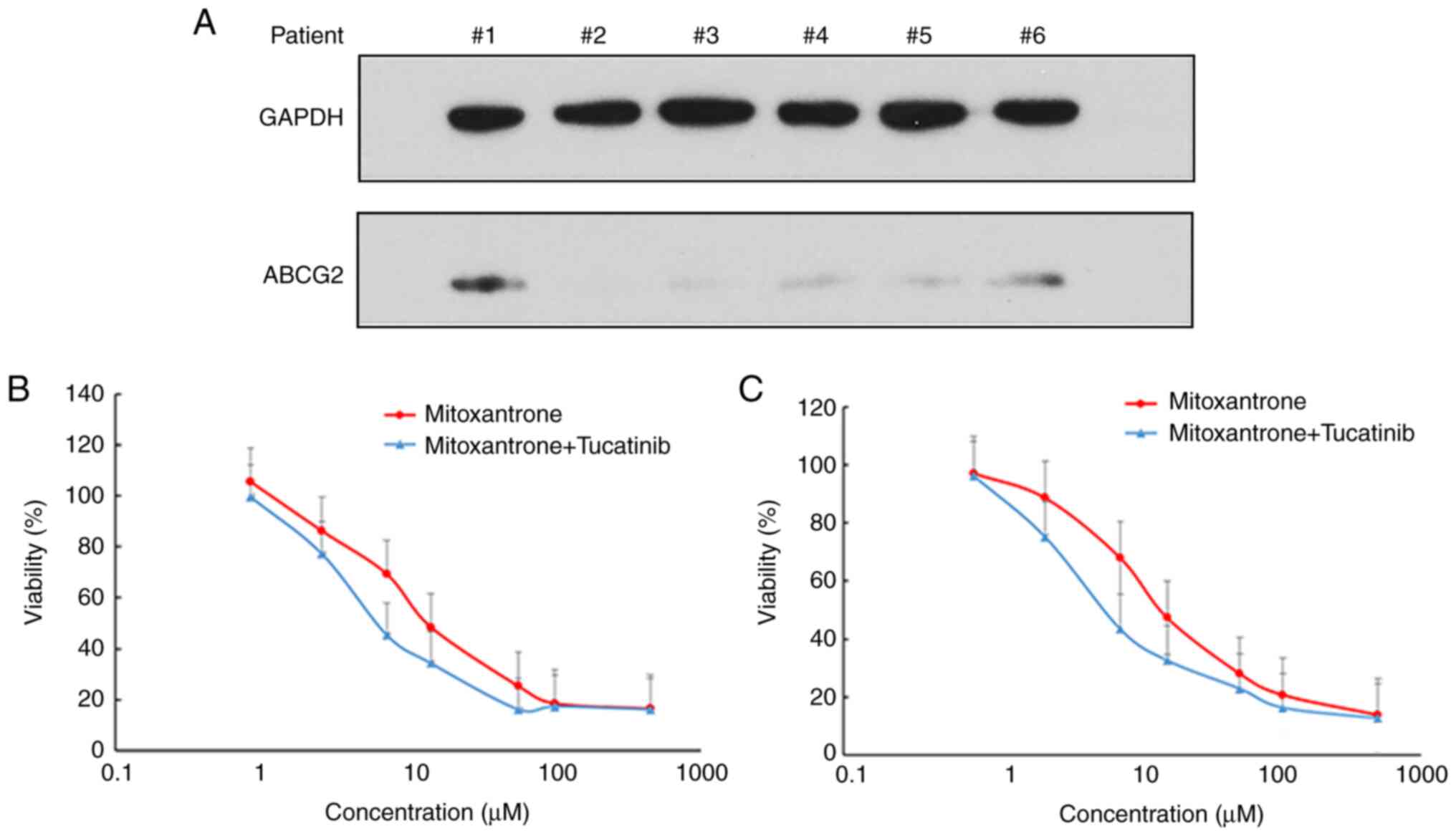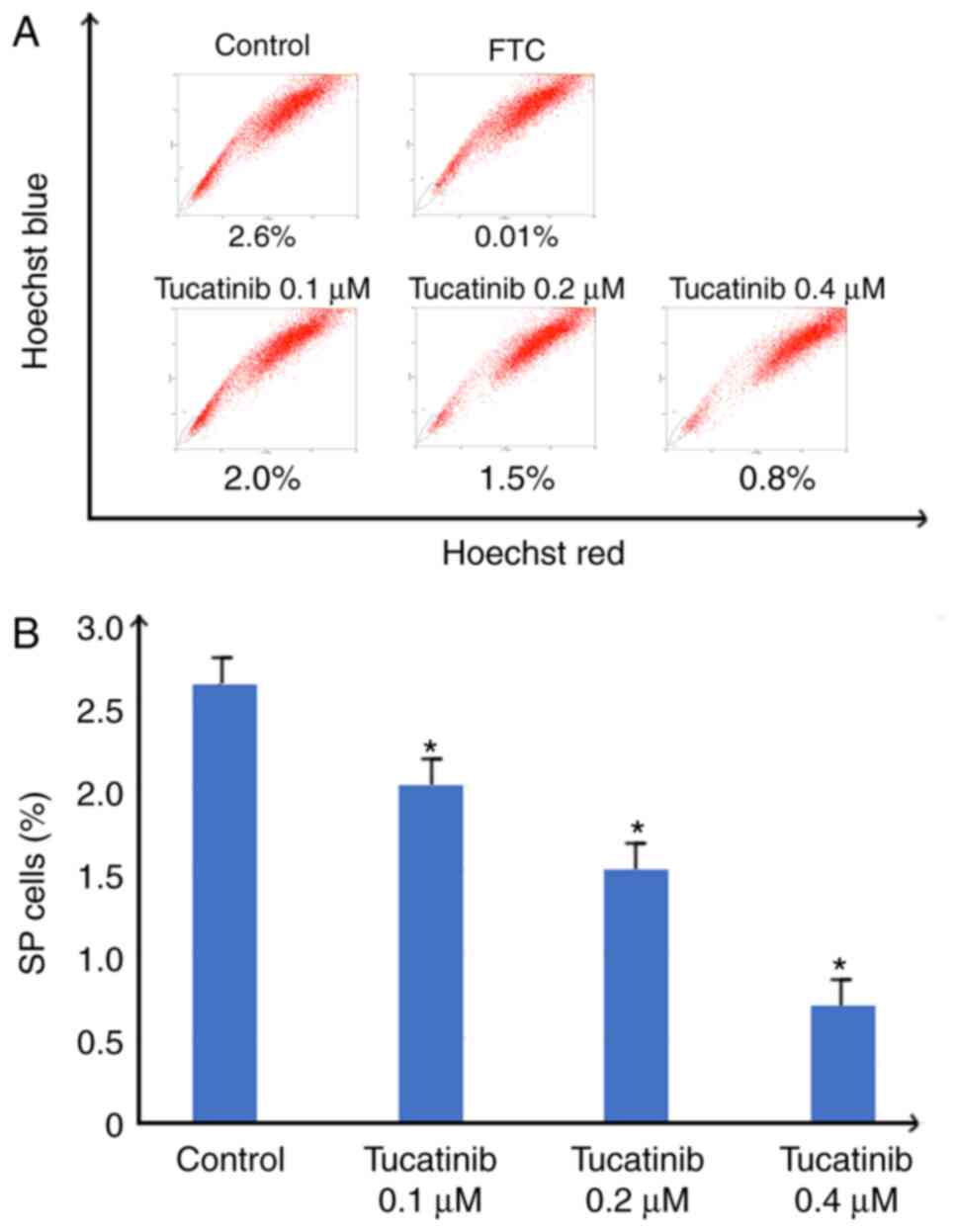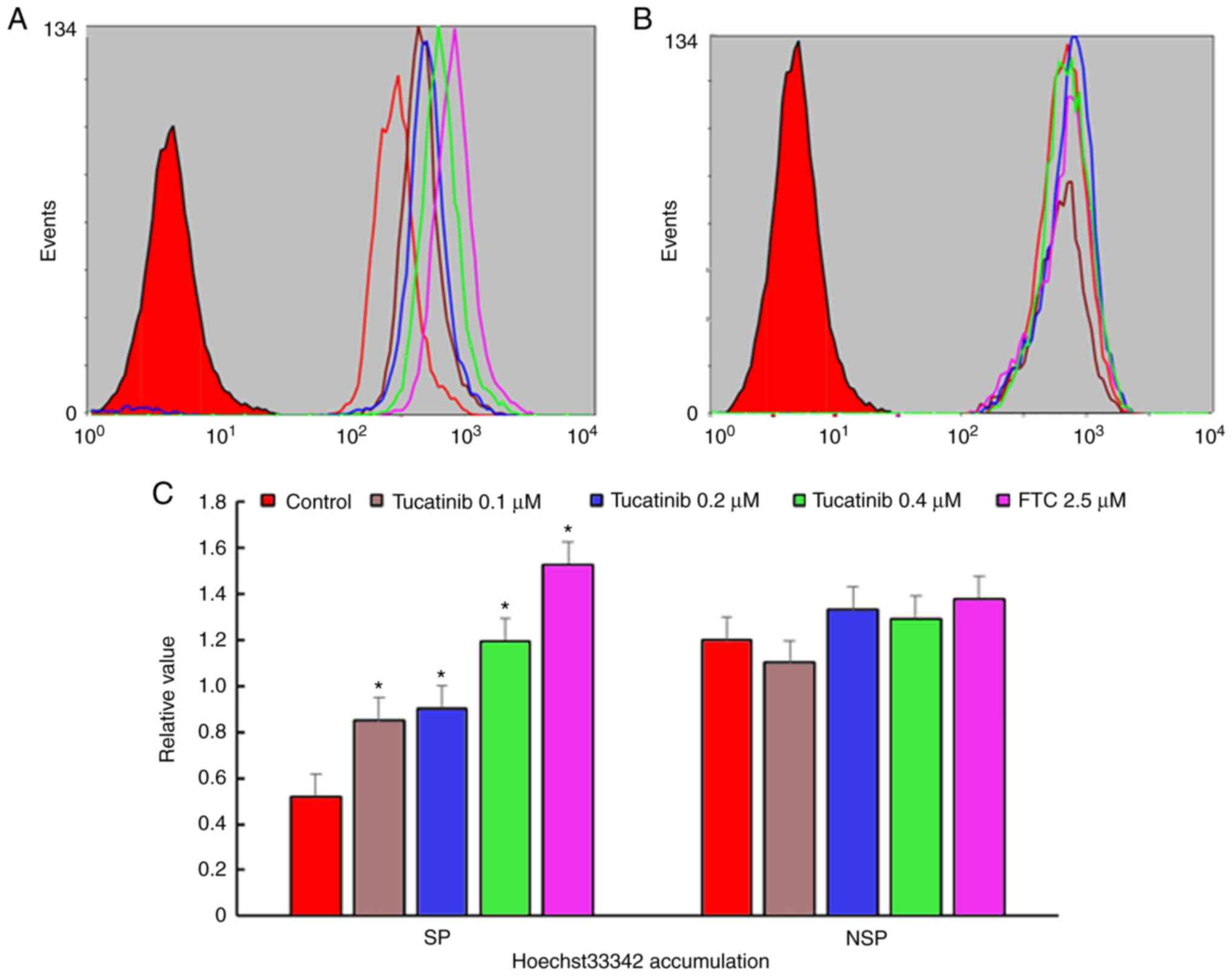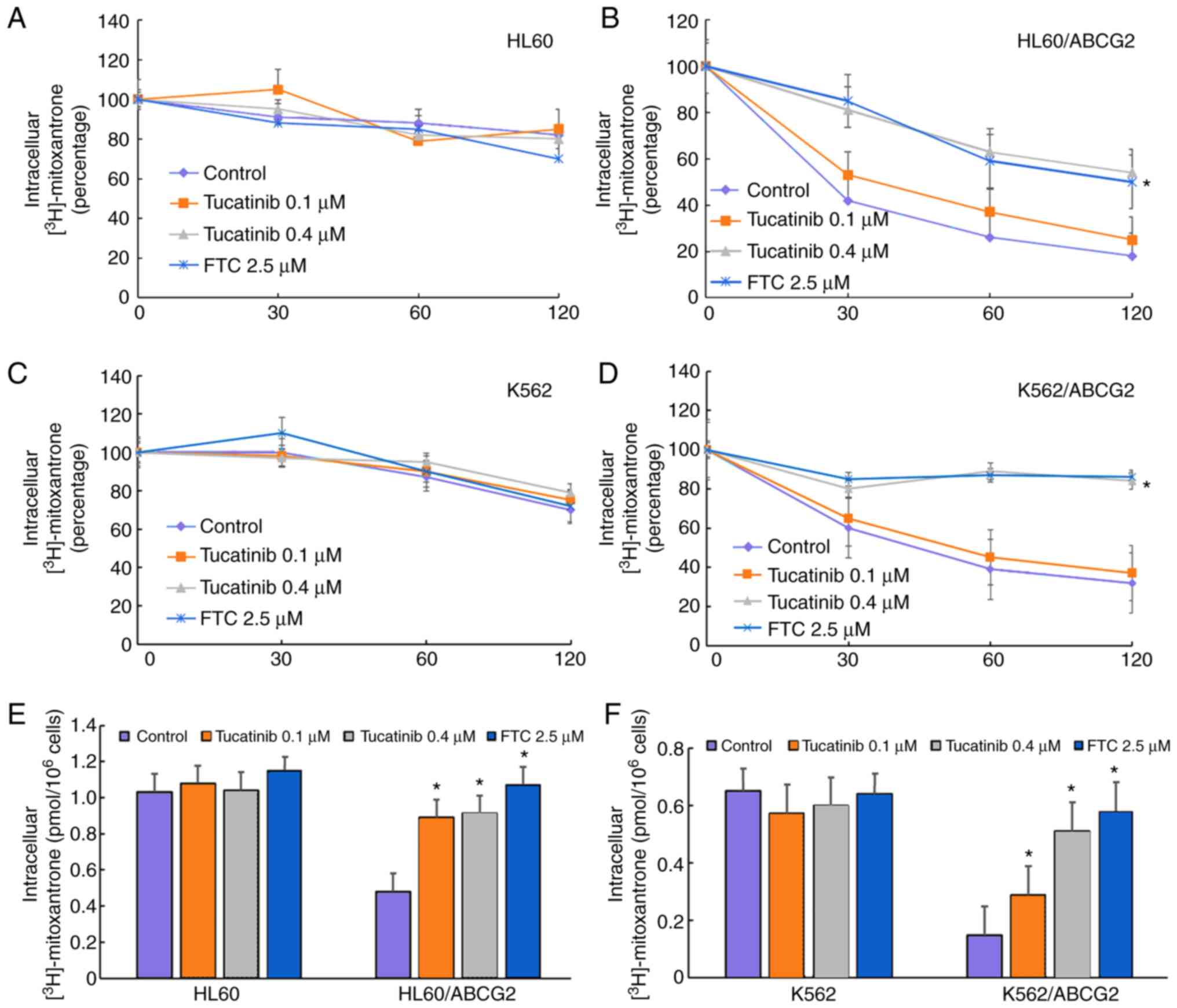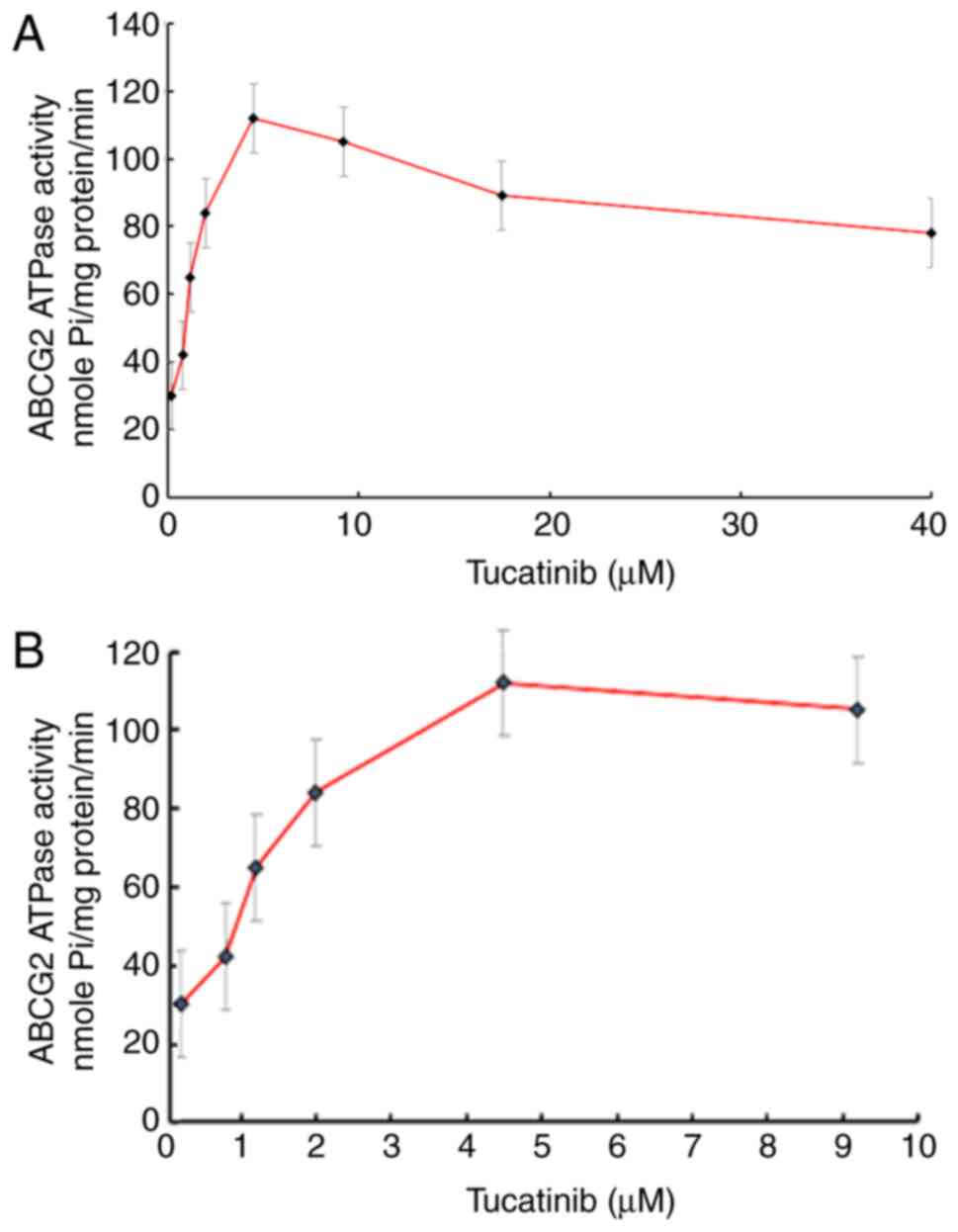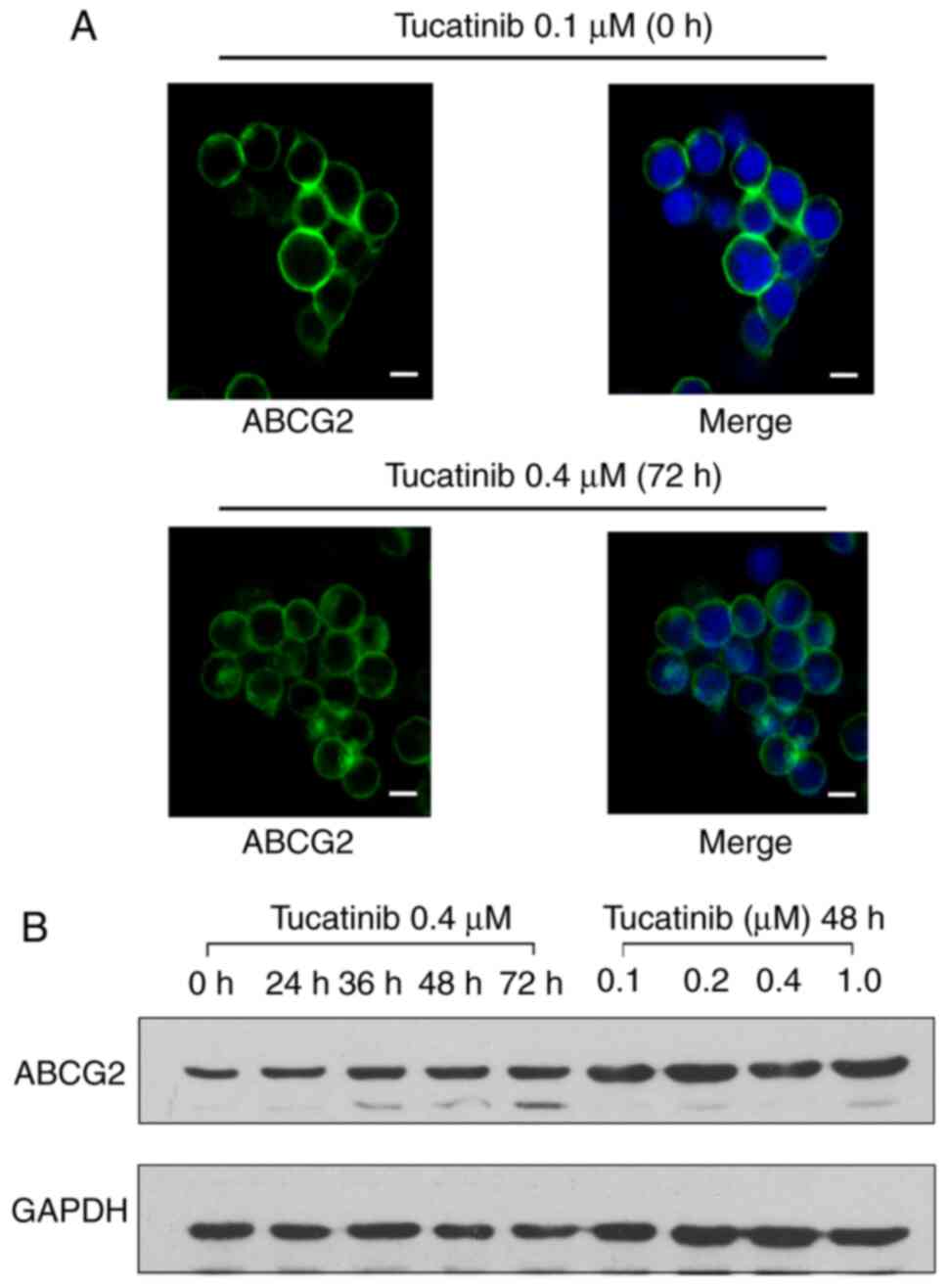|
1
|
Bouvy C, Wannez A, Laloy J, Chatelain C
and Dogné JM: Transfer of multidrug resistance among acute myeloid
leukemia cells via extracellular vesicles and their microRNA cargo.
Leuk Res. 62:70–76. 2017. View Article : Google Scholar : PubMed/NCBI
|
|
2
|
Hochhaus A, Ernst T, Eigendorff E and La
Rosée P: Causes of resistance and treatment choices of second- and
third-line treatment in chronic myelogenous leukemia patients. Ann
Hematol. 94 (Suppl 2):S133–S140. 2015. View Article : Google Scholar : PubMed/NCBI
|
|
3
|
Takeshita A: Efficacy and resistance of
gemtuzumab ozogamicin for acute myeloid leukemia. Int J Hematol.
97:703–716. 2013. View Article : Google Scholar : PubMed/NCBI
|
|
4
|
Tesfatsion DA: Dendritic cell vaccine
against leukemia: Advances and perspectives. Immunotherapy.
6:485–496. 2014. View Article : Google Scholar : PubMed/NCBI
|
|
5
|
Valera ET, Scrideli CA, de Paula Queiroz
RG, Mori BM and Tone LG: Multiple drug resistance protein (MDR-1),
multidrug resistance-related protein (MRP) and lung resistance
protein (LRP) gene expression in childhood acute lymphoblastic
leukemia. Sao Paulo Med J. 122:166–171. 2004. View Article : Google Scholar : PubMed/NCBI
|
|
6
|
Steinbach D and Legrand O: ABC
transporters and drug resistance in leukemia: Was P-gp nothing but
the first head of the hydra? Leukemia. 21:1172–1176. 2007.
View Article : Google Scholar : PubMed/NCBI
|
|
7
|
Plasschaert SL, Van Der Kolk DM, De Bont
ES, Vellenga E, Kamps WA and De Vries EG: Breast cancer resistance
protein (BCRP) in acute leukemia. Leuk Lymphoma. 45:649–654. 2004.
View Article : Google Scholar : PubMed/NCBI
|
|
8
|
Bram EE, Stark M, Raz S and Assaraf YG:
Chemotherapeutic drug-induced ABCG2 promoter demethylation as a
novel mechanism of acquired multidrug resistance. Neoplasia.
11:1359–1370. 2009. View Article : Google Scholar : PubMed/NCBI
|
|
9
|
Damiani D, Tiribelli M, Geromin A,
Michelutti A, Cavallin M, Sperotto A and Fanin R: ABCG2
overexpression in patients with acute myeloid leukemia: Impact on
stem cell transplantation outcome. Am J Hematol. 90:784–789. 2015.
View Article : Google Scholar : PubMed/NCBI
|
|
10
|
Smith PJ, Furon E, Wiltshire M, Campbell
L, Feeney GP, Snyder RD and Errington RJ: ABCG2-associated
resistance to Hoechst 33342 and topotecan in a murine cell model
with constitutive expression of side population characteristics.
Cytometry A. 75:924–933. 2009. View Article : Google Scholar : PubMed/NCBI
|
|
11
|
Moshaver B, Wouters RF, Kelder A,
Ossenkoppele GJ, Westra G, Kwidama Z, Rutten AR, Kaspers G,
Zweegman S, Cloos J and Schuurhuis GJ: Relationship between
CD34/CD38 and side population (SP) defined leukemia stem cell
compartments in acute myeloid leukemia. Leuk Res. 81:27–34. 2019.
View Article : Google Scholar : PubMed/NCBI
|
|
12
|
Hanekamp D, Cloos J and Schuurhuis GJ:
Leukemic stem cells: Identification and clinical application. Int J
Hematol. 105:549–557. 2017. View Article : Google Scholar : PubMed/NCBI
|
|
13
|
Abbott BL: ABCG2 (BCRP): A cytoprotectant
in normal and malignant stem cells. Clin Adv Hematol Oncol.
4:63–72. 2006.PubMed/NCBI
|
|
14
|
Patrawala L, Calhoun T,
Schneider-Broussard R, Zhou J, Claypool K and Tang DG: Side
population is enriched in tumorigenic, stem-like cancer cells,
whereas ABCG2+ and ABCG2-cancer cells are similarly
tumorigenic. Cancer Res. 65:6207–6219. 2005. View Article : Google Scholar : PubMed/NCBI
|
|
15
|
Yazdi MH, Faramarzi MA, Nikfar S and
Abdollahi M: Comparative safety and efficacy of tyrosine kinase
inhibitors (TKIs) in the treatment setting of different types of
leukemia, and different types of adenocarcinoma. Biomed
Pharmacother. 95:1556–1564. 2017. View Article : Google Scholar : PubMed/NCBI
|
|
16
|
Hegedus C, Ozvegy-Laczka C, Apáti A,
Magócsi M, Német K, Orfi L, Kéri G, Katona M, Takáts Z, Váradi A,
et al: Interaction of nilotinib, dasatinib and bosutinib with ABCB1
and ABCG2: Implications for altered anti-cancer effects and
pharmacological properties. Br J Pharmacol. 158:1153–1164. 2009.
View Article : Google Scholar : PubMed/NCBI
|
|
17
|
Wang XK, He Jh, Xu Jh, Ye S, Wang F, Zhang
H, Huang Zc, To KK and Fu Lw: Afatinib enhances the efficacy of
conventional chemotherapeutic agents by eradicating cancer
stem-like cells. Cancer Res. 74:4431–4445. 2014. View Article : Google Scholar : PubMed/NCBI
|
|
18
|
Murthy R, Borges VF, Conlin A, Chaves J,
Chamberlain M, Gray T, Vo A and Hamilton E: Tucatinib with
capecitabine and trastuzumab in advanced HER2-positive metastatic
breast cancer with and without brain metastases: A non-randomised,
open-label, phase 1b study. Lancet Oncol. 19:880–888. 2018.
View Article : Google Scholar : PubMed/NCBI
|
|
19
|
Kulukian A, Lee P, Taylor J, Rosler R, de
Vries P, Watson D, Forero-Torres A and Peterson S: Preclinical
activity of HER2-selective tyrosine kinase inhibitor tucatinib as a
single agent or in combination with trastuzumab or docetaxel in
solid tumor models. Mol Cancer Ther. 19:976–987. 2020. View Article : Google Scholar : PubMed/NCBI
|
|
20
|
Lee A: Tucatinib: First approval. Drugs.
80:1033–1038. 2020. View Article : Google Scholar : PubMed/NCBI
|
|
21
|
Borges VF, Ferrario C, Aucoin N, Falkson
C, Khan Q, Krop I, Welch S, Conlin A, Chaves J, Bedard PL, et al:
Tucatinib combined with ado-trastuzumab emtansine in advanced
ERBB2/HER2-positive metastatic breast cancer: A phase 1b clinical
trial. Jama Oncol. 4:1214–1220. 2018. View Article : Google Scholar : PubMed/NCBI
|
|
22
|
Filho OM, Leone JP, Li T, Tan-Wasielewski
Z, Trippa L, Barry WT, Younger J, Lawler E, Walker L, Freedman RA,
et al: Phase I dose-escalation trial of tucatinib in combination
with trastuzumab in patients with HER2-positive breast cancer brain
metastases. Ann Oncol. 31:1231–1239. 2020. View Article : Google Scholar : PubMed/NCBI
|
|
23
|
Li J, Kumar P, Anreddy N, Zhang YK, Wang
YJ, Chen Y, Talele TT, Gupta K, Trombetta LD and Chen ZS:
Quizartinib (AC220) reverses ABCG2-mediated multidrug resistance:
In vitro and in vivo studies. Oncotarget. 8:93785–93799. 2017.
View Article : Google Scholar : PubMed/NCBI
|
|
24
|
Sugimoto Y, Tsukahara S, Imai Y, Sugimoto
Y, Ueda K and Tsuruo T: Reversal of breast cancer resistance
protein-mediated drug resistance by estrogen antagonists and
agonists. Mol Cancer Ther. 2:105–112. 2003.PubMed/NCBI
|
|
25
|
Wang DS, Patel A, Shukla S, Zhang YK, Wang
YJ, Kathawala RJ, Robey RW, Zhang L, Yang DH, Talele TT, et al:
Icotinib antagonizes ABCG2-mediated multidrug resistance, but not
the pemetrexed resistance mediated by thymidylate synthase and
ABCG2. Oncotarget. 5:4529–4542. 2014. View Article : Google Scholar : PubMed/NCBI
|
|
26
|
Shi Z, Tiwari AK, Shukla S, Robey RW,
Singh S, Kim IW, Bates SE, Peng X, Abraham I, Ambudkar SV, et al:
Sildenafil reverses ABCB1- and ABCG2-mediated chemotherapeutic drug
resistance. Cancer Res. 71:3029–3041. 2011. View Article : Google Scholar : PubMed/NCBI
|
|
27
|
Wang XH, Wang XK, Liang YJ, Shi Z, Zhang
JY, Chen LM and Fu LW: A cell-based screen for anticancer activity
of 13 pyrazolone derivatives. Chin J Cancer. 29:980–987. 2010.
View Article : Google Scholar : PubMed/NCBI
|
|
28
|
Shi Z, Liang YJ, Chen ZS, Wang XH, Ding Y,
Chen LM and Fu LW: Overexpression of survivin and XIAP in MDR
cancer cells unrelated to P-glycoprotein. Oncol Rep. 17:969–976.
2007.PubMed/NCBI
|
|
29
|
Shi Z, Parmar S, Peng XX, Shen T, Robey
RW, Bates SE, Fu LW, Shao Y, Chen YM, Zang F and Chen ZS: The
epidermal growth factor tyrosine kinase inhibitor AG1478 and
erlotinib reverse ABCG2-mediated drug resistance. Oncol Rep.
21:483–489. 2009.PubMed/NCBI
|
|
30
|
Ji N, Yang Y, Cai CY, Lei ZN, Wang JQ,
Gupta P, Teng QX, Chen ZS, Kong D and Yang DH: VS-4718 antagonizes
multidrug resistance in ABCB1- and ABCG2-overexpressing cancer
cells by inhibiting the efflux function of ABC transporters. Front
Pharmacol. 9:12362018. View Article : Google Scholar : PubMed/NCBI
|
|
31
|
Percival ME, Lai C, Estey E and Hourigan
CS: Bone marrow evaluation for diagnosis and monitoring of acute
myeloid leukemia. Blood Rev. 31:185–192. 2017. View Article : Google Scholar : PubMed/NCBI
|
|
32
|
Vieyra DS, Rosen A and Goodell MA:
Identification and characterization of side population cells in
embryonic stem cell cultures. Stem Cells Dev. 18:1155–1166. 2009.
View Article : Google Scholar : PubMed/NCBI
|
|
33
|
Ji N, Yang Y, Lei ZN, Cai CY, Wang JQ,
Gupta P, Xian X, Yang DH, Kong D and Chen ZS: Ulixertinib (BVD-523)
antagonizes ABCB1- and ABCG2-mediated chemotherapeutic drug
resistance. Biochem Pharmacol. 158:274–285. 2018. View Article : Google Scholar : PubMed/NCBI
|
|
34
|
Dai Cl, Tiwari AK, Wu CP, Su XD, Wang SR,
Liu Dg, Ashby CJ JR, Huang Y, Robey RW, Liang YJ, et al: Lapatinib
(Tykerb, GW572016) reverses multidrug resistance in cancer cells by
inhibiting the activity of ATP-binding cassette subfamily B member
1 and G member 2. Cancer Res. 68:7905–7914. 2008. View Article : Google Scholar : PubMed/NCBI
|
|
35
|
Cai CY, Zhai H, Lei ZN, Tan CP, Chen BL,
Du ZY, Wang JQ, Zhang YK, Wang YJ, Gupta P, et al: Benzoyl indoles
with metabolic stability as reversal agents for ABCG2-mediated
multidrug resistance. Eur J Med Chem. 179:849–862. 2019. View Article : Google Scholar : PubMed/NCBI
|
|
36
|
Jing W, Zhang X, Chen R, Ye X, Zhou M, Li
W, Yan W, Xuyun X and Peng J: KD025, an anti-adipocyte
differentiation drug, enhances the efficacy of conventional
chemotherapeutic drugs in ABCG2-overexpressing leukemia cells.
Oncol Lett. 20:3092020. View Article : Google Scholar : PubMed/NCBI
|
|
37
|
Litman T, Druley TE, Stein WD and Bates
SE: From MDR to MXR: New understanding of multidrug resistance
systems, their properties and clinical significance. Cell Mol Life
Sci. 58:931–959. 2001. View Article : Google Scholar : PubMed/NCBI
|
|
38
|
Spagnuolo P: Interactions between
nutraceutical supplements and standard acute myeloid leukemia
chemotherapeutics. J Pharm Pharm Sci. 18:339–343. 2015. View Article : Google Scholar : PubMed/NCBI
|
|
39
|
List AF: The role of multidrug resistance
and its pharmacological modulation in acute myeloid leukemia.
Leukemia. 10 (Suppl 1):S36–S38. 1996.PubMed/NCBI
|
|
40
|
Polgar O and Bates SE: ABC transporters in
the balance: Is there a role in multidrug resistance? Biochem Soc
Trans. 33:241–245. 2005. View Article : Google Scholar : PubMed/NCBI
|
|
41
|
Robey RW, Pluchino KM, Hall MD, Fojo AT,
Bates SE and Gottesman MM: Revisiting the role of ABC transporters
in multidrug-resistant cancer. Nat Rev Cancer. 18:452–464. 2018.
View Article : Google Scholar : PubMed/NCBI
|
|
42
|
Robey RW, To KK, Polgar O, Dohse M, Fetsch
P, Dean M and Bates SE: ABCG2: A perspective. Adv Drug Deliv Rev.
61:3–13. 2009. View Article : Google Scholar : PubMed/NCBI
|
|
43
|
Carrillo IO, Peñafiel CR, Peralta EM,
Fuller ER, Ipiña JJ, Cruz FC, Guerrero EG, Jaloma JC, Vargas KN and
Tovar AM: Clinical significance of the ABCB1 and ABCG2 gene
expression levels in acute lymphoblastic leukemia. Hematology.
22:286–291. 2017. View Article : Google Scholar : PubMed/NCBI
|
|
44
|
Jiang ZP, Zhao XL, Takahashi N, Angelini
S, Dubashi B, Sun L and Xu P: Trough concentration and ABCG2
polymorphism are better to predict imatinib response in chronic
myeloid leukemia: A meta-analysis. Pharmacogenomics. 18:35–56.
2017. View Article : Google Scholar : PubMed/NCBI
|
|
45
|
Wang F, Wang XK, Shi CJ, Zhang H, Hu YP,
Chen YF and Fu LW: Nilotinib enhances the efficacy of conventional
chemotherapeutic drugs in CD34+CD38− stem
cells and ABC transporter overexpressing leukemia cells. Molecules.
19:3356–3375. 2014. View Article : Google Scholar : PubMed/NCBI
|
|
46
|
Li D, Su D, Xue L, Liu Y and Pang W:
Establishment of pancreatic cancer stem cells by flow cytometry and
their biological characteristics. Int J Clin Exp Pathol.
8:11218–11223. 2015.PubMed/NCBI
|
|
47
|
Russo A, Franchina T, Ricciardi GR,
Smiroldo V, Picciotto M, Zanghì M, Rolfo C and Adamo V: Third
generation EGFR TKIs in EGFR-mutated NSCLC: Where are we now and
where are we going. Crit Rev Oncol Hematol. 117:38–47. 2017.
View Article : Google Scholar : PubMed/NCBI
|
|
48
|
Kouhpeikar H, Butler AE, Bamian F, Barreto
GE, Majeed M and Sahebkar A: Curcumin as a therapeutic agent in
leukemia. J Cell Physiol. 234:12404–12414. 2019. View Article : Google Scholar : PubMed/NCBI
|
|
49
|
Arrigoni E, Del RM, Galimberti S, Restante
G, Rofi E, Crucitta S, Baratè C, Petrini M, Danesi R and Di Paolo
A: Concise review: Chronic myeloid leukemia: Stem cell niche and
response to pharmacologic treatment. Stem Cells Transl Med.
7:305–314. 2018. View Article : Google Scholar : PubMed/NCBI
|
|
50
|
Dohse M, Scharenberg C, Shukla S, Robey
RW, Volkmann T, Deeken JF, Brendel C, Ambudkar SV, Neubauer A and
Bates SE: Comparison of ATP-binding cassette transporter
interactions with the tyrosine kinase inhibitors imatinib,
nilotinib, and dasatinib. Drug Metab Dispos. 38:1371–1380. 2010.
View Article : Google Scholar : PubMed/NCBI
|
|
51
|
Wang X, Goldstein D, Crowe PJ and Yang JL:
Next-Generation EGFR/HER tyrosine kinase inhibitors for the
treatment of patients with non-small-cell lung cancer harboring
EGFR mutations: A review of the evidence. Onco Targets Ther.
9:5461–5473. 2016. View Article : Google Scholar : PubMed/NCBI
|
|
52
|
Murthy RK, Loi S, Okines A, Paplomata E,
Hamilton E, Hurvitz SA, Lin NU, Borges V, Abramson V, Anders C, et
al: Tucatinib, trastuzumab, and capecitabine for HER2-positive
metastatic breast cancer. N Engl J Med. 382:597–609. 2020.
View Article : Google Scholar : PubMed/NCBI
|
|
53
|
Lin NU, Borges V, Anders C, Murthy RK,
Paplomata E, Hamilton E, Hurvitz S, Loi S, Okines A, Abramson V, et
al: Intracranial efficacy and survival with tucatinib plus
trastuzumab and capecitabine for previously treated HER2-positive
breast cancer with brain metastases in the HER2CLIMB trial. J Clin
Oncol. 38:2610–2619. 2020. View Article : Google Scholar : PubMed/NCBI
|
















